The Impact of Domestic Tourism on Economic Growth in Australia, NSW
VerifiedAdded on 2020/11/12
|10
|3296
|454
Report
AI Summary
This report provides a comprehensive overview of domestic tourism in New South Wales (NSW), Australia. It begins by examining the growth rate of domestic tourism from 2016 to 2017, highlighting the sector's significant contribution to the state's economy. The report delves into the economic benefits, such as increased gross domestic product, job creation, and export revenue. It also explores the key challenges faced by the domestic tourism sector, offering insights into factors influencing tourism trends. The analysis includes statistics on visitor arrivals, expenditure, and the impact of tourism on various sectors, including employment and government revenue. The report underscores the importance of tourism in NSW's economic landscape and provides a detailed analysis of its growth, economic contributions, and the challenges faced by the industry.
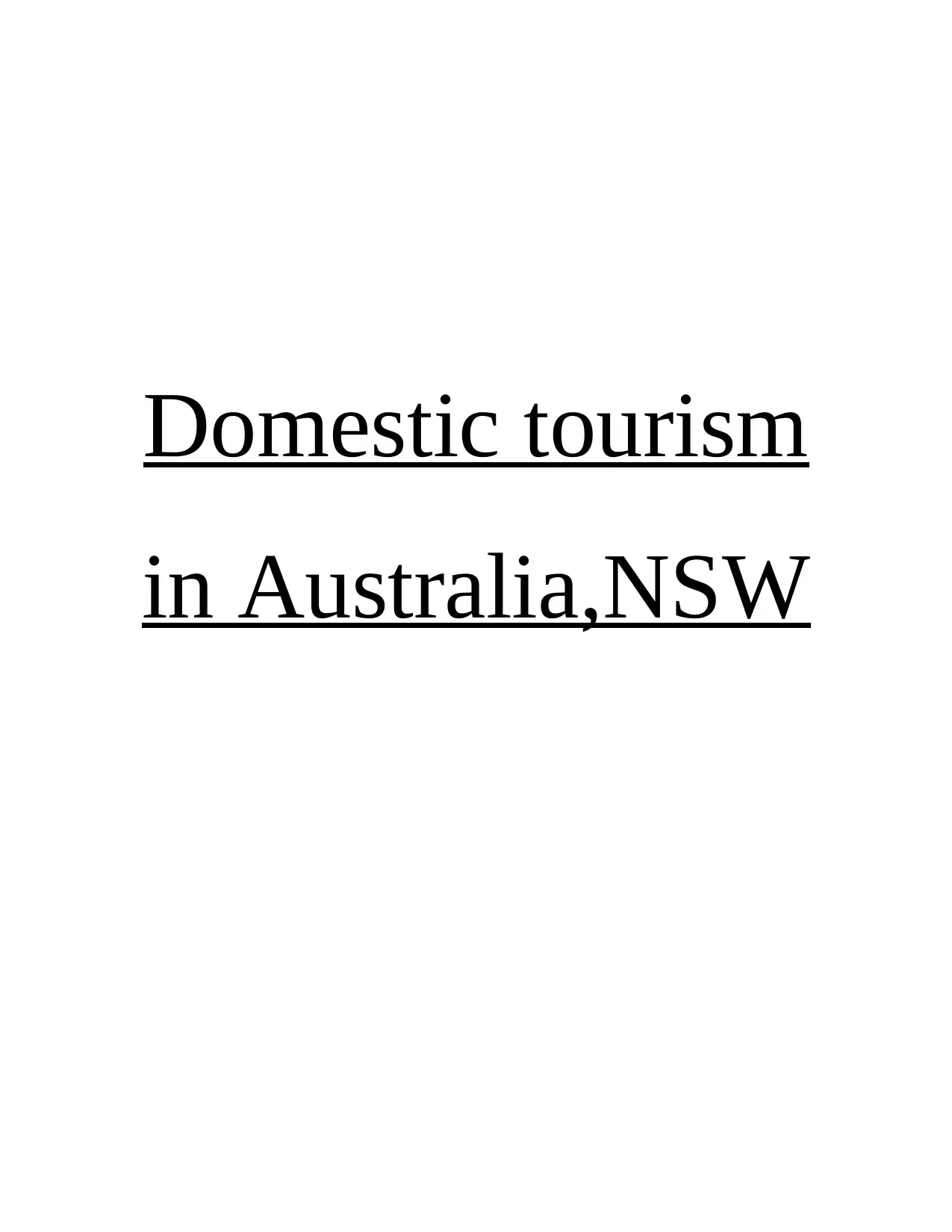
Domestic tourism
in Australia,NSW
in Australia,NSW
Paraphrase This Document
Need a fresh take? Get an instant paraphrase of this document with our AI Paraphraser
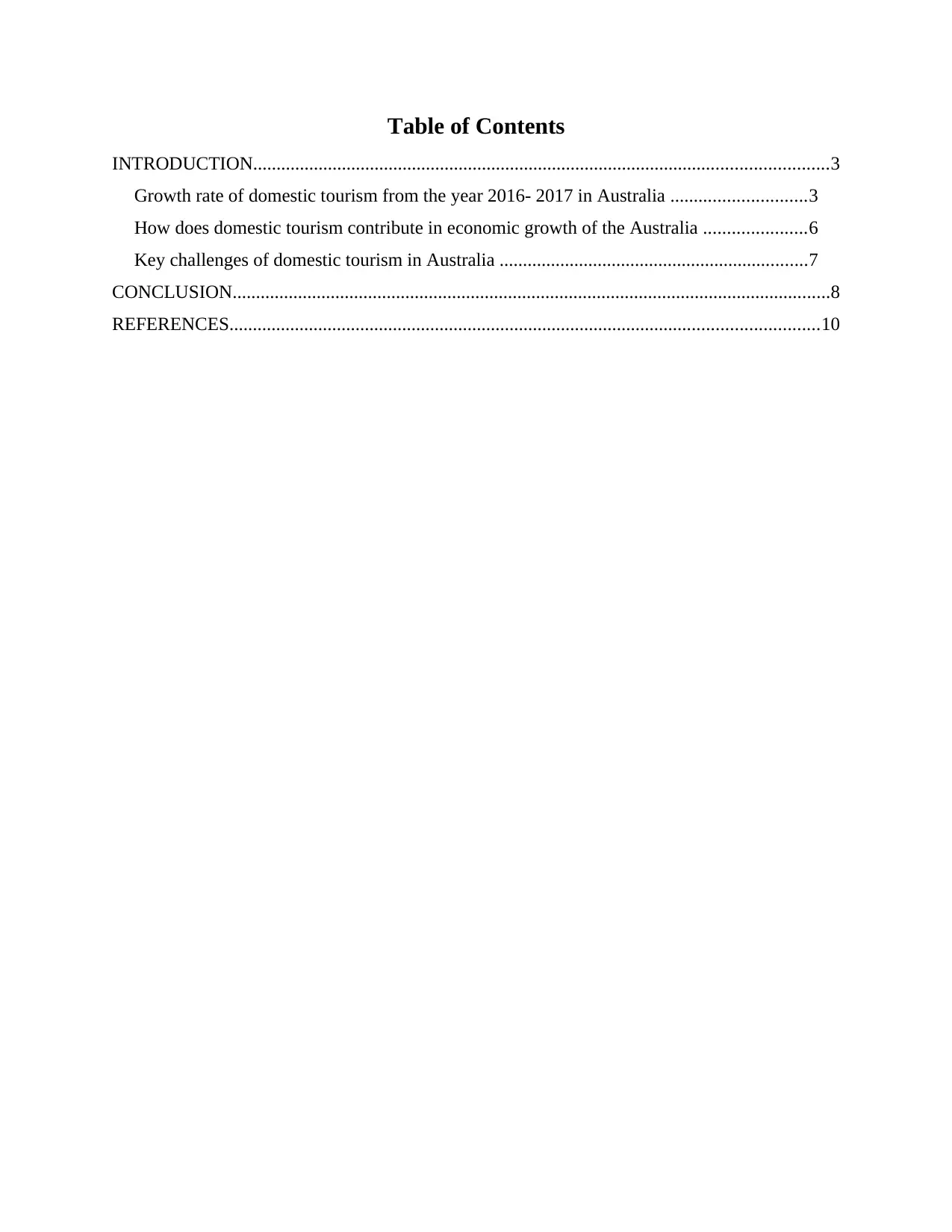
Table of Contents
INTRODUCTION...........................................................................................................................3
Growth rate of domestic tourism from the year 2016- 2017 in Australia .............................3
How does domestic tourism contribute in economic growth of the Australia ......................6
Key challenges of domestic tourism in Australia ..................................................................7
CONCLUSION................................................................................................................................8
REFERENCES..............................................................................................................................10
INTRODUCTION...........................................................................................................................3
Growth rate of domestic tourism from the year 2016- 2017 in Australia .............................3
How does domestic tourism contribute in economic growth of the Australia ......................6
Key challenges of domestic tourism in Australia ..................................................................7
CONCLUSION................................................................................................................................8
REFERENCES..............................................................................................................................10

INTRODUCTION
Tourism is defined as one of the largest industry and growing economic sector. In new south
wales , Tourism is responsible for regional development because it creates new economic
activities. Tourism impacts country economically by balance of payments, increasing gross
income and production (Mason, 2015). On the other hand, there are some limitations of tourism
i.e. on environment. In the following report, the topics which are discussed are growth rate of
domestic tourism from the year 2016-2017 in new South Wales, new south wales , how does
tourism contribute in economic growth of new south wales and at last the key challenges of
domestic tourism in new south wales . The New South Wales is a southern eastern new south
wales n state which is distinguished by coastal cities and national parks. Moreover, it attracts a
lot of tourists every year. Sydney is the capital of NSW and it is home for several iconic
structures like Sydney Opera House and Harbour Bridge. The other features that attract tourists
are rugged Blue mountains, rainforests and outback towns where opals are mined. The tourism
in new south wales is an important factor of growth and rise of new south Wales n economy. It
attracts tourists because of presence of it’s natural beauty like great infrastructure, landscapes,
seas, lakes, food, wildlife, etc. The new south Wales of Australia have pristine beaches,
breathtaking natural treasures and it one of the largest natural treasures and is called as the most
vibrant cities of world.
NSW is famous for day tourism as well as overnight stay tourism. A day tourism is
defined as tourism in which a tourist is attracted towards several attractive places. On the other
hand, overnight tourism is that tourism in which tourists travel to a country in which they do not
have residence. This is outside their usual environment and it is not for a period of more than
an year. In overnight stay tourism, guests or tourists stay in a tourist accommodation
establishment or non rented accommodation. There are different famous hotels in NSW where a
tourist can stay while travelling in new south Wales like Perisher Manor, Hayes Beach House,
Mahogany Lodge, The Stan well Beach Art house , Currarong Cottage, etc. The day tourism
means that tourists go to a day trip and visit attractive and famous places of the new south wales
like Broken Hills, Tamworth, Sydney, Snowy mountains, outback NSW, South coast, Hunter
valley, North Coast, Lord Howe island, etc.
Tourism is defined as one of the largest industry and growing economic sector. In new south
wales , Tourism is responsible for regional development because it creates new economic
activities. Tourism impacts country economically by balance of payments, increasing gross
income and production (Mason, 2015). On the other hand, there are some limitations of tourism
i.e. on environment. In the following report, the topics which are discussed are growth rate of
domestic tourism from the year 2016-2017 in new South Wales, new south wales , how does
tourism contribute in economic growth of new south wales and at last the key challenges of
domestic tourism in new south wales . The New South Wales is a southern eastern new south
wales n state which is distinguished by coastal cities and national parks. Moreover, it attracts a
lot of tourists every year. Sydney is the capital of NSW and it is home for several iconic
structures like Sydney Opera House and Harbour Bridge. The other features that attract tourists
are rugged Blue mountains, rainforests and outback towns where opals are mined. The tourism
in new south wales is an important factor of growth and rise of new south Wales n economy. It
attracts tourists because of presence of it’s natural beauty like great infrastructure, landscapes,
seas, lakes, food, wildlife, etc. The new south Wales of Australia have pristine beaches,
breathtaking natural treasures and it one of the largest natural treasures and is called as the most
vibrant cities of world.
NSW is famous for day tourism as well as overnight stay tourism. A day tourism is
defined as tourism in which a tourist is attracted towards several attractive places. On the other
hand, overnight tourism is that tourism in which tourists travel to a country in which they do not
have residence. This is outside their usual environment and it is not for a period of more than
an year. In overnight stay tourism, guests or tourists stay in a tourist accommodation
establishment or non rented accommodation. There are different famous hotels in NSW where a
tourist can stay while travelling in new south Wales like Perisher Manor, Hayes Beach House,
Mahogany Lodge, The Stan well Beach Art house , Currarong Cottage, etc. The day tourism
means that tourists go to a day trip and visit attractive and famous places of the new south wales
like Broken Hills, Tamworth, Sydney, Snowy mountains, outback NSW, South coast, Hunter
valley, North Coast, Lord Howe island, etc.
⊘ This is a preview!⊘
Do you want full access?
Subscribe today to unlock all pages.

Trusted by 1+ million students worldwide
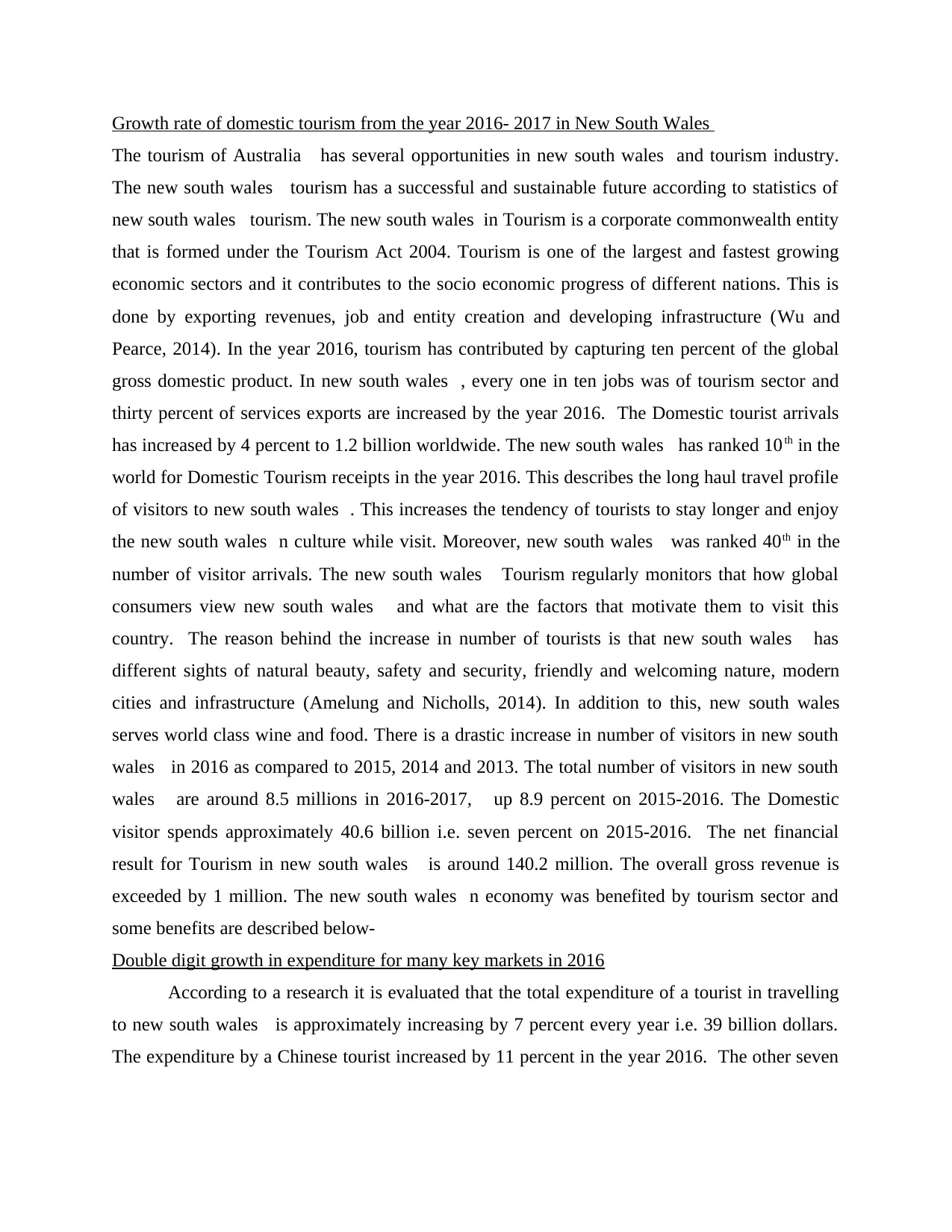
Growth rate of domestic tourism from the year 2016- 2017 in New South Wales
The tourism of Australia has several opportunities in new south wales and tourism industry.
The new south wales tourism has a successful and sustainable future according to statistics of
new south wales tourism. The new south wales in Tourism is a corporate commonwealth entity
that is formed under the Tourism Act 2004. Tourism is one of the largest and fastest growing
economic sectors and it contributes to the socio economic progress of different nations. This is
done by exporting revenues, job and entity creation and developing infrastructure (Wu and
Pearce, 2014). In the year 2016, tourism has contributed by capturing ten percent of the global
gross domestic product. In new south wales , every one in ten jobs was of tourism sector and
thirty percent of services exports are increased by the year 2016. The Domestic tourist arrivals
has increased by 4 percent to 1.2 billion worldwide. The new south wales has ranked 10th in the
world for Domestic Tourism receipts in the year 2016. This describes the long haul travel profile
of visitors to new south wales . This increases the tendency of tourists to stay longer and enjoy
the new south wales n culture while visit. Moreover, new south wales was ranked 40th in the
number of visitor arrivals. The new south wales Tourism regularly monitors that how global
consumers view new south wales and what are the factors that motivate them to visit this
country. The reason behind the increase in number of tourists is that new south wales has
different sights of natural beauty, safety and security, friendly and welcoming nature, modern
cities and infrastructure (Amelung and Nicholls, 2014). In addition to this, new south wales
serves world class wine and food. There is a drastic increase in number of visitors in new south
wales in 2016 as compared to 2015, 2014 and 2013. The total number of visitors in new south
wales are around 8.5 millions in 2016-2017, up 8.9 percent on 2015-2016. The Domestic
visitor spends approximately 40.6 billion i.e. seven percent on 2015-2016. The net financial
result for Tourism in new south wales is around 140.2 million. The overall gross revenue is
exceeded by 1 million. The new south wales n economy was benefited by tourism sector and
some benefits are described below-
Double digit growth in expenditure for many key markets in 2016
According to a research it is evaluated that the total expenditure of a tourist in travelling
to new south wales is approximately increasing by 7 percent every year i.e. 39 billion dollars.
The expenditure by a Chinese tourist increased by 11 percent in the year 2016. The other seven
The tourism of Australia has several opportunities in new south wales and tourism industry.
The new south wales tourism has a successful and sustainable future according to statistics of
new south wales tourism. The new south wales in Tourism is a corporate commonwealth entity
that is formed under the Tourism Act 2004. Tourism is one of the largest and fastest growing
economic sectors and it contributes to the socio economic progress of different nations. This is
done by exporting revenues, job and entity creation and developing infrastructure (Wu and
Pearce, 2014). In the year 2016, tourism has contributed by capturing ten percent of the global
gross domestic product. In new south wales , every one in ten jobs was of tourism sector and
thirty percent of services exports are increased by the year 2016. The Domestic tourist arrivals
has increased by 4 percent to 1.2 billion worldwide. The new south wales has ranked 10th in the
world for Domestic Tourism receipts in the year 2016. This describes the long haul travel profile
of visitors to new south wales . This increases the tendency of tourists to stay longer and enjoy
the new south wales n culture while visit. Moreover, new south wales was ranked 40th in the
number of visitor arrivals. The new south wales Tourism regularly monitors that how global
consumers view new south wales and what are the factors that motivate them to visit this
country. The reason behind the increase in number of tourists is that new south wales has
different sights of natural beauty, safety and security, friendly and welcoming nature, modern
cities and infrastructure (Amelung and Nicholls, 2014). In addition to this, new south wales
serves world class wine and food. There is a drastic increase in number of visitors in new south
wales in 2016 as compared to 2015, 2014 and 2013. The total number of visitors in new south
wales are around 8.5 millions in 2016-2017, up 8.9 percent on 2015-2016. The Domestic
visitor spends approximately 40.6 billion i.e. seven percent on 2015-2016. The net financial
result for Tourism in new south wales is around 140.2 million. The overall gross revenue is
exceeded by 1 million. The new south wales n economy was benefited by tourism sector and
some benefits are described below-
Double digit growth in expenditure for many key markets in 2016
According to a research it is evaluated that the total expenditure of a tourist in travelling
to new south wales is approximately increasing by 7 percent every year i.e. 39 billion dollars.
The expenditure by a Chinese tourist increased by 11 percent in the year 2016. The other seven
Paraphrase This Document
Need a fresh take? Get an instant paraphrase of this document with our AI Paraphraser
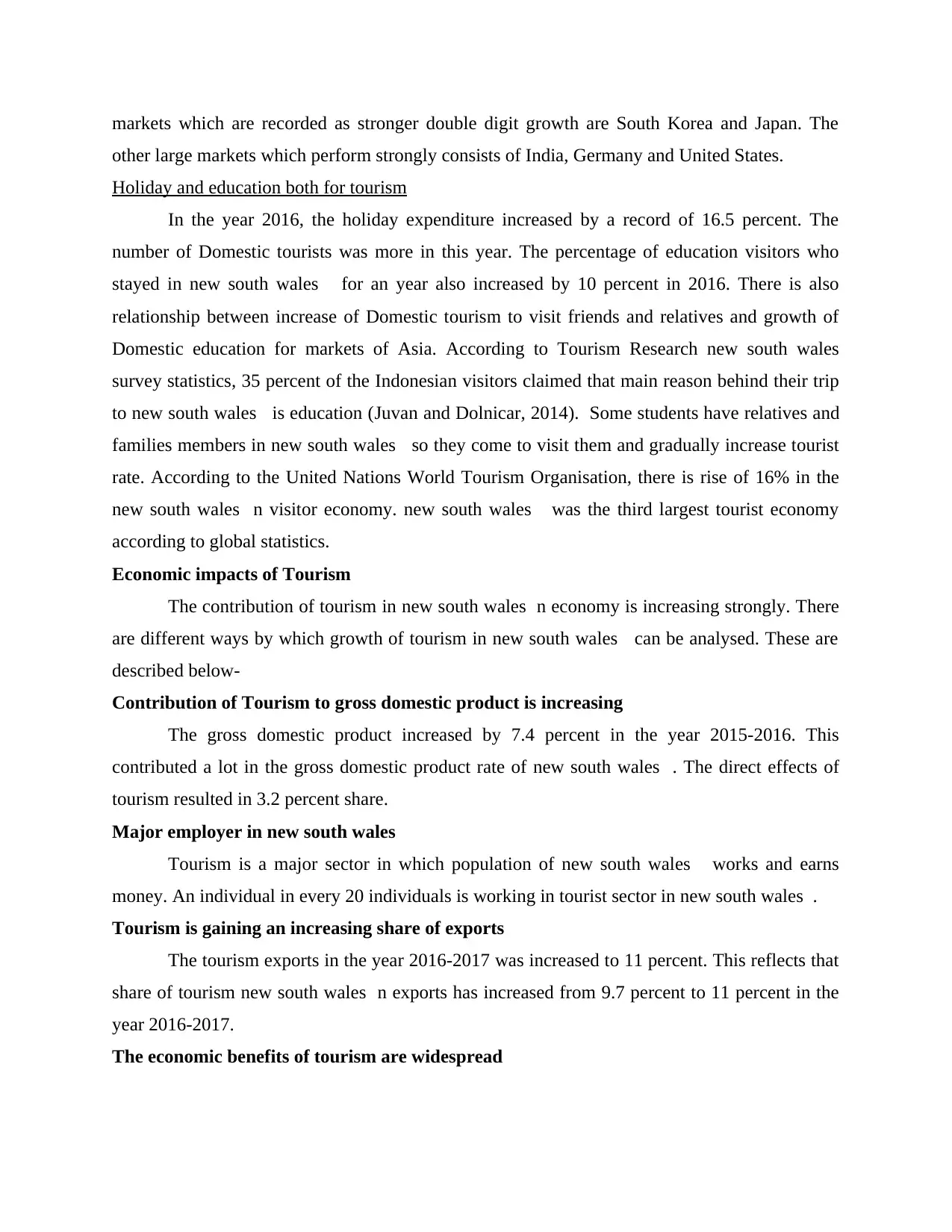
markets which are recorded as stronger double digit growth are South Korea and Japan. The
other large markets which perform strongly consists of India, Germany and United States.
Holiday and education both for tourism
In the year 2016, the holiday expenditure increased by a record of 16.5 percent. The
number of Domestic tourists was more in this year. The percentage of education visitors who
stayed in new south wales for an year also increased by 10 percent in 2016. There is also
relationship between increase of Domestic tourism to visit friends and relatives and growth of
Domestic education for markets of Asia. According to Tourism Research new south wales
survey statistics, 35 percent of the Indonesian visitors claimed that main reason behind their trip
to new south wales is education (Juvan and Dolnicar, 2014). Some students have relatives and
families members in new south wales so they come to visit them and gradually increase tourist
rate. According to the United Nations World Tourism Organisation, there is rise of 16% in the
new south wales n visitor economy. new south wales was the third largest tourist economy
according to global statistics.
Economic impacts of Tourism
The contribution of tourism in new south wales n economy is increasing strongly. There
are different ways by which growth of tourism in new south wales can be analysed. These are
described below-
Contribution of Tourism to gross domestic product is increasing
The gross domestic product increased by 7.4 percent in the year 2015-2016. This
contributed a lot in the gross domestic product rate of new south wales . The direct effects of
tourism resulted in 3.2 percent share.
Major employer in new south wales
Tourism is a major sector in which population of new south wales works and earns
money. An individual in every 20 individuals is working in tourist sector in new south wales .
Tourism is gaining an increasing share of exports
The tourism exports in the year 2016-2017 was increased to 11 percent. This reflects that
share of tourism new south wales n exports has increased from 9.7 percent to 11 percent in the
year 2016-2017.
The economic benefits of tourism are widespread
other large markets which perform strongly consists of India, Germany and United States.
Holiday and education both for tourism
In the year 2016, the holiday expenditure increased by a record of 16.5 percent. The
number of Domestic tourists was more in this year. The percentage of education visitors who
stayed in new south wales for an year also increased by 10 percent in 2016. There is also
relationship between increase of Domestic tourism to visit friends and relatives and growth of
Domestic education for markets of Asia. According to Tourism Research new south wales
survey statistics, 35 percent of the Indonesian visitors claimed that main reason behind their trip
to new south wales is education (Juvan and Dolnicar, 2014). Some students have relatives and
families members in new south wales so they come to visit them and gradually increase tourist
rate. According to the United Nations World Tourism Organisation, there is rise of 16% in the
new south wales n visitor economy. new south wales was the third largest tourist economy
according to global statistics.
Economic impacts of Tourism
The contribution of tourism in new south wales n economy is increasing strongly. There
are different ways by which growth of tourism in new south wales can be analysed. These are
described below-
Contribution of Tourism to gross domestic product is increasing
The gross domestic product increased by 7.4 percent in the year 2015-2016. This
contributed a lot in the gross domestic product rate of new south wales . The direct effects of
tourism resulted in 3.2 percent share.
Major employer in new south wales
Tourism is a major sector in which population of new south wales works and earns
money. An individual in every 20 individuals is working in tourist sector in new south wales .
Tourism is gaining an increasing share of exports
The tourism exports in the year 2016-2017 was increased to 11 percent. This reflects that
share of tourism new south wales n exports has increased from 9.7 percent to 11 percent in the
year 2016-2017.
The economic benefits of tourism are widespread
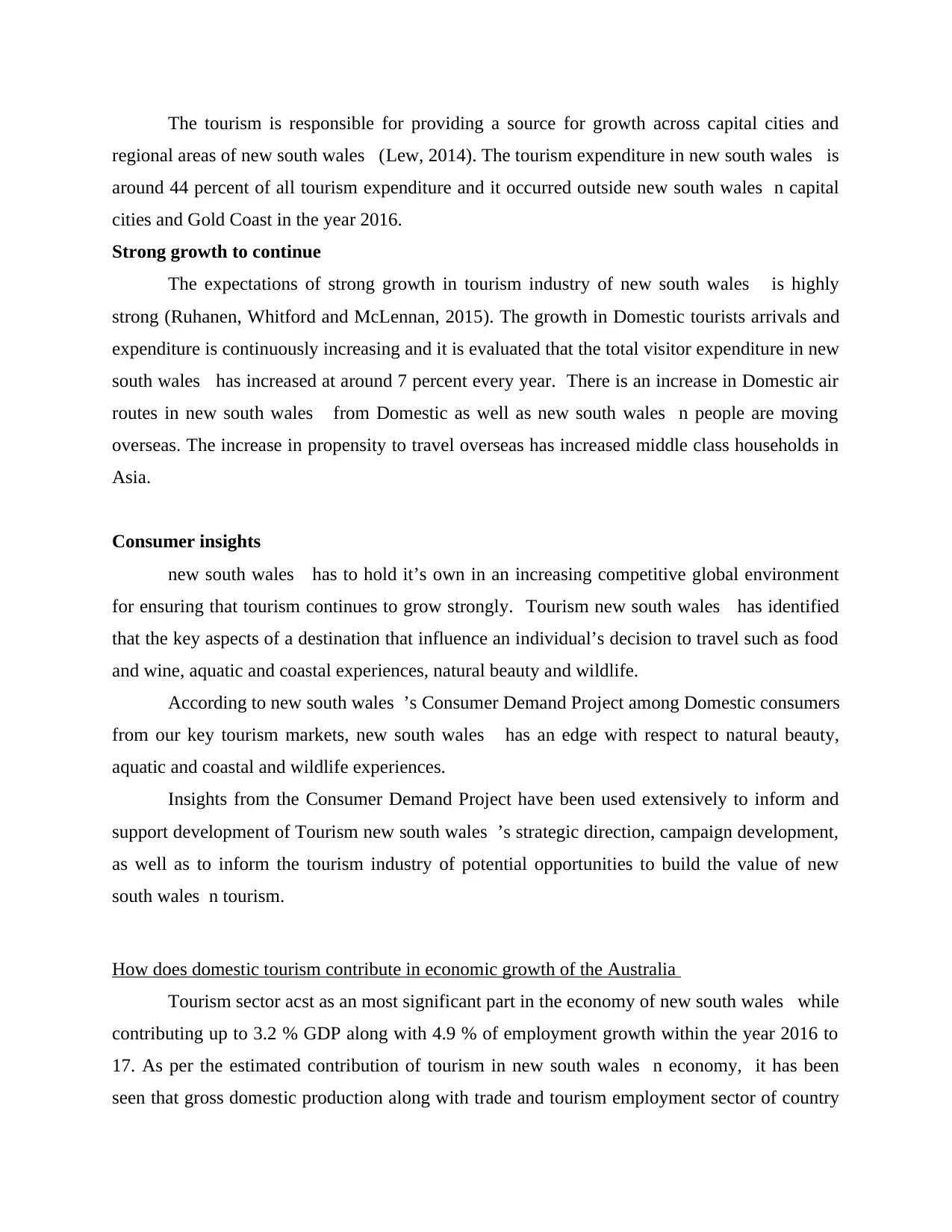
The tourism is responsible for providing a source for growth across capital cities and
regional areas of new south wales (Lew, 2014). The tourism expenditure in new south wales is
around 44 percent of all tourism expenditure and it occurred outside new south wales n capital
cities and Gold Coast in the year 2016.
Strong growth to continue
The expectations of strong growth in tourism industry of new south wales is highly
strong (Ruhanen, Whitford and McLennan, 2015). The growth in Domestic tourists arrivals and
expenditure is continuously increasing and it is evaluated that the total visitor expenditure in new
south wales has increased at around 7 percent every year. There is an increase in Domestic air
routes in new south wales from Domestic as well as new south wales n people are moving
overseas. The increase in propensity to travel overseas has increased middle class households in
Asia.
Consumer insights
new south wales has to hold it’s own in an increasing competitive global environment
for ensuring that tourism continues to grow strongly. Tourism new south wales has identified
that the key aspects of a destination that influence an individual’s decision to travel such as food
and wine, aquatic and coastal experiences, natural beauty and wildlife.
According to new south wales ’s Consumer Demand Project among Domestic consumers
from our key tourism markets, new south wales has an edge with respect to natural beauty,
aquatic and coastal and wildlife experiences.
Insights from the Consumer Demand Project have been used extensively to inform and
support development of Tourism new south wales ’s strategic direction, campaign development,
as well as to inform the tourism industry of potential opportunities to build the value of new
south wales n tourism.
How does domestic tourism contribute in economic growth of the Australia
Tourism sector acst as an most significant part in the economy of new south wales while
contributing up to 3.2 % GDP along with 4.9 % of employment growth within the year 2016 to
17. As per the estimated contribution of tourism in new south wales n economy, it has been
seen that gross domestic production along with trade and tourism employment sector of country
regional areas of new south wales (Lew, 2014). The tourism expenditure in new south wales is
around 44 percent of all tourism expenditure and it occurred outside new south wales n capital
cities and Gold Coast in the year 2016.
Strong growth to continue
The expectations of strong growth in tourism industry of new south wales is highly
strong (Ruhanen, Whitford and McLennan, 2015). The growth in Domestic tourists arrivals and
expenditure is continuously increasing and it is evaluated that the total visitor expenditure in new
south wales has increased at around 7 percent every year. There is an increase in Domestic air
routes in new south wales from Domestic as well as new south wales n people are moving
overseas. The increase in propensity to travel overseas has increased middle class households in
Asia.
Consumer insights
new south wales has to hold it’s own in an increasing competitive global environment
for ensuring that tourism continues to grow strongly. Tourism new south wales has identified
that the key aspects of a destination that influence an individual’s decision to travel such as food
and wine, aquatic and coastal experiences, natural beauty and wildlife.
According to new south wales ’s Consumer Demand Project among Domestic consumers
from our key tourism markets, new south wales has an edge with respect to natural beauty,
aquatic and coastal and wildlife experiences.
Insights from the Consumer Demand Project have been used extensively to inform and
support development of Tourism new south wales ’s strategic direction, campaign development,
as well as to inform the tourism industry of potential opportunities to build the value of new
south wales n tourism.
How does domestic tourism contribute in economic growth of the Australia
Tourism sector acst as an most significant part in the economy of new south wales while
contributing up to 3.2 % GDP along with 4.9 % of employment growth within the year 2016 to
17. As per the estimated contribution of tourism in new south wales n economy, it has been
seen that gross domestic production along with trade and tourism employment sector of country
⊘ This is a preview!⊘
Do you want full access?
Subscribe today to unlock all pages.

Trusted by 1+ million students worldwide
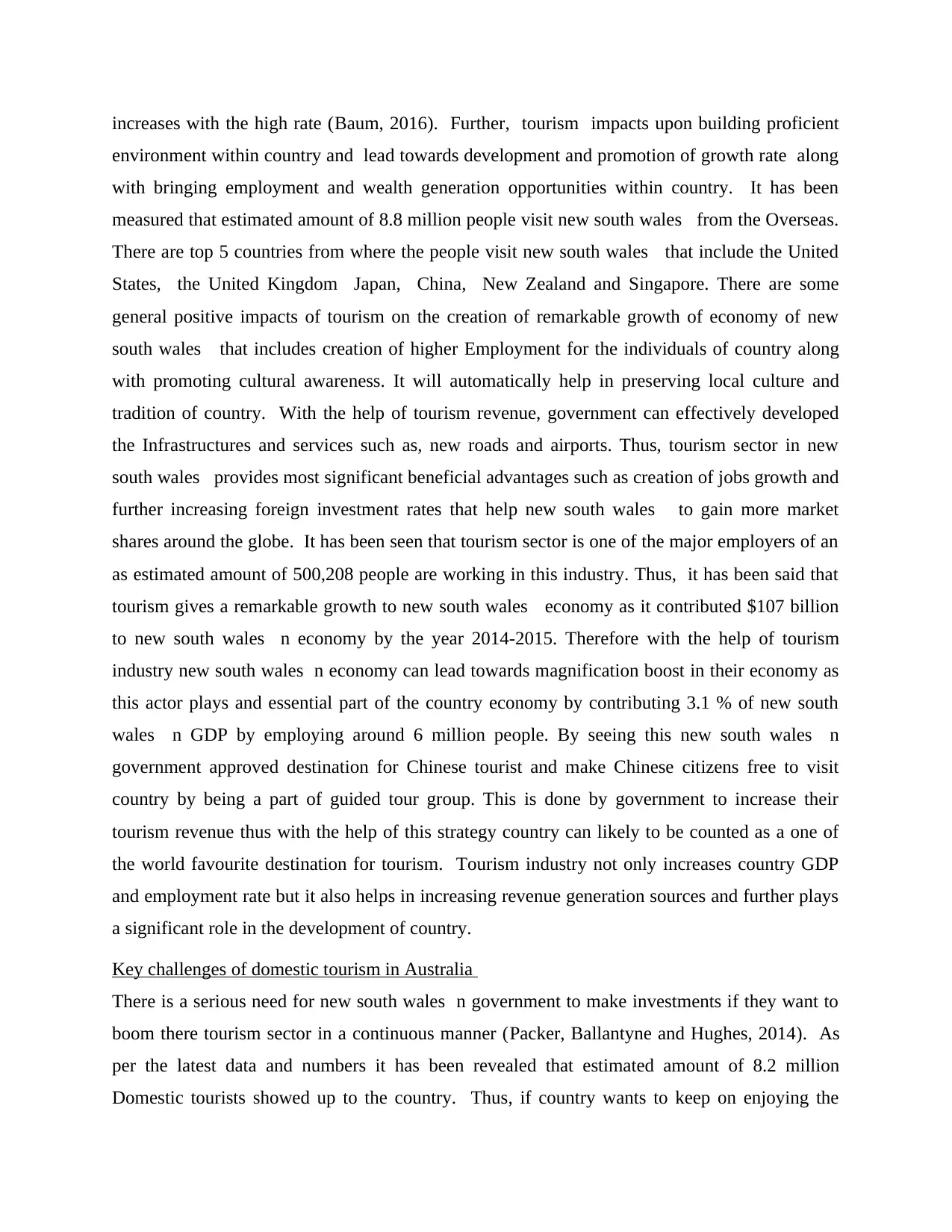
increases with the high rate (Baum, 2016). Further, tourism impacts upon building proficient
environment within country and lead towards development and promotion of growth rate along
with bringing employment and wealth generation opportunities within country. It has been
measured that estimated amount of 8.8 million people visit new south wales from the Overseas.
There are top 5 countries from where the people visit new south wales that include the United
States, the United Kingdom Japan, China, New Zealand and Singapore. There are some
general positive impacts of tourism on the creation of remarkable growth of economy of new
south wales that includes creation of higher Employment for the individuals of country along
with promoting cultural awareness. It will automatically help in preserving local culture and
tradition of country. With the help of tourism revenue, government can effectively developed
the Infrastructures and services such as, new roads and airports. Thus, tourism sector in new
south wales provides most significant beneficial advantages such as creation of jobs growth and
further increasing foreign investment rates that help new south wales to gain more market
shares around the globe. It has been seen that tourism sector is one of the major employers of an
as estimated amount of 500,208 people are working in this industry. Thus, it has been said that
tourism gives a remarkable growth to new south wales economy as it contributed $107 billion
to new south wales n economy by the year 2014-2015. Therefore with the help of tourism
industry new south wales n economy can lead towards magnification boost in their economy as
this actor plays and essential part of the country economy by contributing 3.1 % of new south
wales n GDP by employing around 6 million people. By seeing this new south wales n
government approved destination for Chinese tourist and make Chinese citizens free to visit
country by being a part of guided tour group. This is done by government to increase their
tourism revenue thus with the help of this strategy country can likely to be counted as a one of
the world favourite destination for tourism. Tourism industry not only increases country GDP
and employment rate but it also helps in increasing revenue generation sources and further plays
a significant role in the development of country.
Key challenges of domestic tourism in Australia
There is a serious need for new south wales n government to make investments if they want to
boom there tourism sector in a continuous manner (Packer, Ballantyne and Hughes, 2014). As
per the latest data and numbers it has been revealed that estimated amount of 8.2 million
Domestic tourists showed up to the country. Thus, if country wants to keep on enjoying the
environment within country and lead towards development and promotion of growth rate along
with bringing employment and wealth generation opportunities within country. It has been
measured that estimated amount of 8.8 million people visit new south wales from the Overseas.
There are top 5 countries from where the people visit new south wales that include the United
States, the United Kingdom Japan, China, New Zealand and Singapore. There are some
general positive impacts of tourism on the creation of remarkable growth of economy of new
south wales that includes creation of higher Employment for the individuals of country along
with promoting cultural awareness. It will automatically help in preserving local culture and
tradition of country. With the help of tourism revenue, government can effectively developed
the Infrastructures and services such as, new roads and airports. Thus, tourism sector in new
south wales provides most significant beneficial advantages such as creation of jobs growth and
further increasing foreign investment rates that help new south wales to gain more market
shares around the globe. It has been seen that tourism sector is one of the major employers of an
as estimated amount of 500,208 people are working in this industry. Thus, it has been said that
tourism gives a remarkable growth to new south wales economy as it contributed $107 billion
to new south wales n economy by the year 2014-2015. Therefore with the help of tourism
industry new south wales n economy can lead towards magnification boost in their economy as
this actor plays and essential part of the country economy by contributing 3.1 % of new south
wales n GDP by employing around 6 million people. By seeing this new south wales n
government approved destination for Chinese tourist and make Chinese citizens free to visit
country by being a part of guided tour group. This is done by government to increase their
tourism revenue thus with the help of this strategy country can likely to be counted as a one of
the world favourite destination for tourism. Tourism industry not only increases country GDP
and employment rate but it also helps in increasing revenue generation sources and further plays
a significant role in the development of country.
Key challenges of domestic tourism in Australia
There is a serious need for new south wales n government to make investments if they want to
boom there tourism sector in a continuous manner (Packer, Ballantyne and Hughes, 2014). As
per the latest data and numbers it has been revealed that estimated amount of 8.2 million
Domestic tourists showed up to the country. Thus, if country wants to keep on enjoying the
Paraphrase This Document
Need a fresh take? Get an instant paraphrase of this document with our AI Paraphraser
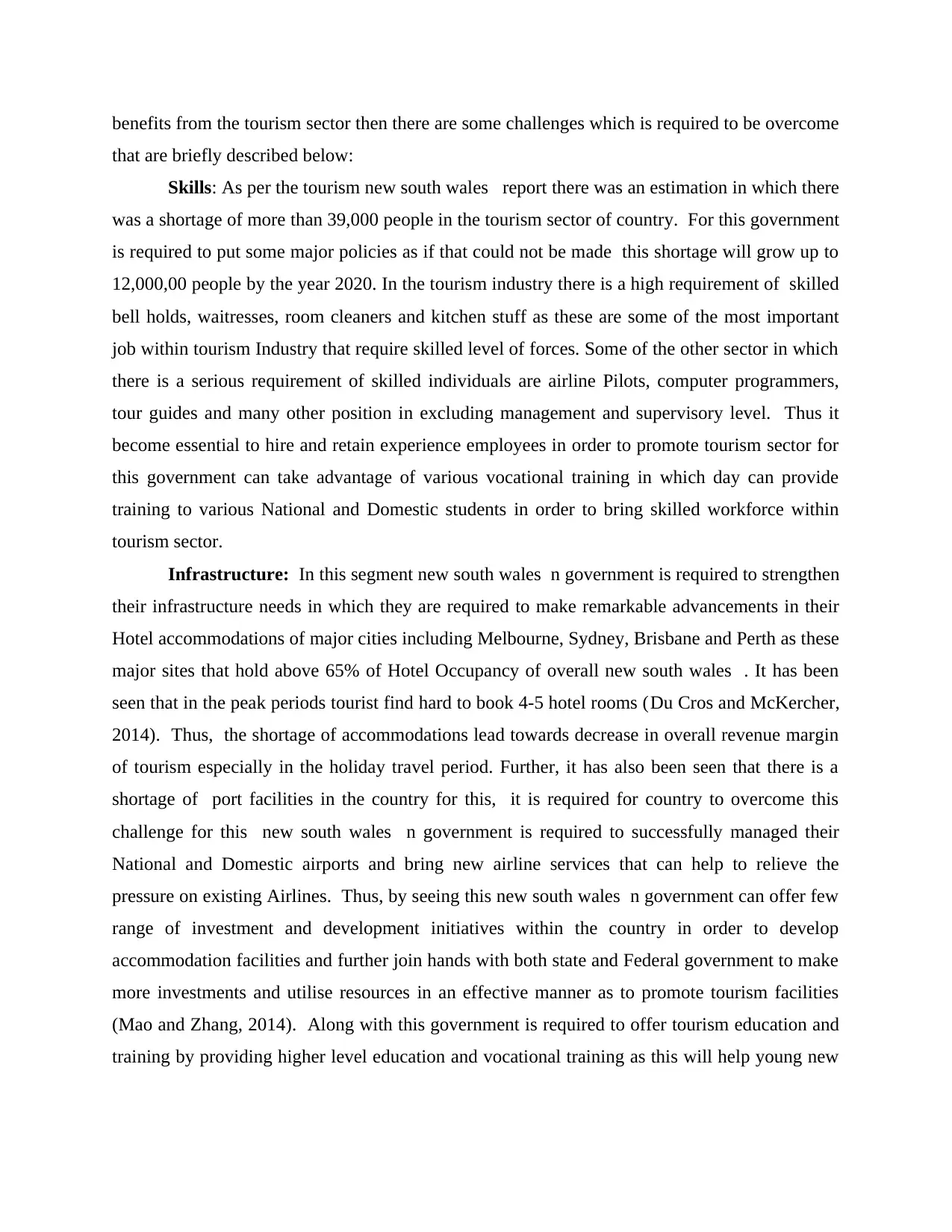
benefits from the tourism sector then there are some challenges which is required to be overcome
that are briefly described below:
Skills: As per the tourism new south wales report there was an estimation in which there
was a shortage of more than 39,000 people in the tourism sector of country. For this government
is required to put some major policies as if that could not be made this shortage will grow up to
12,000,00 people by the year 2020. In the tourism industry there is a high requirement of skilled
bell holds, waitresses, room cleaners and kitchen stuff as these are some of the most important
job within tourism Industry that require skilled level of forces. Some of the other sector in which
there is a serious requirement of skilled individuals are airline Pilots, computer programmers,
tour guides and many other position in excluding management and supervisory level. Thus it
become essential to hire and retain experience employees in order to promote tourism sector for
this government can take advantage of various vocational training in which day can provide
training to various National and Domestic students in order to bring skilled workforce within
tourism sector.
Infrastructure: In this segment new south wales n government is required to strengthen
their infrastructure needs in which they are required to make remarkable advancements in their
Hotel accommodations of major cities including Melbourne, Sydney, Brisbane and Perth as these
major sites that hold above 65% of Hotel Occupancy of overall new south wales . It has been
seen that in the peak periods tourist find hard to book 4-5 hotel rooms (Du Cros and McKercher,
2014). Thus, the shortage of accommodations lead towards decrease in overall revenue margin
of tourism especially in the holiday travel period. Further, it has also been seen that there is a
shortage of port facilities in the country for this, it is required for country to overcome this
challenge for this new south wales n government is required to successfully managed their
National and Domestic airports and bring new airline services that can help to relieve the
pressure on existing Airlines. Thus, by seeing this new south wales n government can offer few
range of investment and development initiatives within the country in order to develop
accommodation facilities and further join hands with both state and Federal government to make
more investments and utilise resources in an effective manner as to promote tourism facilities
(Mao and Zhang, 2014). Along with this government is required to offer tourism education and
training by providing higher level education and vocational training as this will help young new
that are briefly described below:
Skills: As per the tourism new south wales report there was an estimation in which there
was a shortage of more than 39,000 people in the tourism sector of country. For this government
is required to put some major policies as if that could not be made this shortage will grow up to
12,000,00 people by the year 2020. In the tourism industry there is a high requirement of skilled
bell holds, waitresses, room cleaners and kitchen stuff as these are some of the most important
job within tourism Industry that require skilled level of forces. Some of the other sector in which
there is a serious requirement of skilled individuals are airline Pilots, computer programmers,
tour guides and many other position in excluding management and supervisory level. Thus it
become essential to hire and retain experience employees in order to promote tourism sector for
this government can take advantage of various vocational training in which day can provide
training to various National and Domestic students in order to bring skilled workforce within
tourism sector.
Infrastructure: In this segment new south wales n government is required to strengthen
their infrastructure needs in which they are required to make remarkable advancements in their
Hotel accommodations of major cities including Melbourne, Sydney, Brisbane and Perth as these
major sites that hold above 65% of Hotel Occupancy of overall new south wales . It has been
seen that in the peak periods tourist find hard to book 4-5 hotel rooms (Du Cros and McKercher,
2014). Thus, the shortage of accommodations lead towards decrease in overall revenue margin
of tourism especially in the holiday travel period. Further, it has also been seen that there is a
shortage of port facilities in the country for this, it is required for country to overcome this
challenge for this new south wales n government is required to successfully managed their
National and Domestic airports and bring new airline services that can help to relieve the
pressure on existing Airlines. Thus, by seeing this new south wales n government can offer few
range of investment and development initiatives within the country in order to develop
accommodation facilities and further join hands with both state and Federal government to make
more investments and utilise resources in an effective manner as to promote tourism facilities
(Mao and Zhang, 2014). Along with this government is required to offer tourism education and
training by providing higher level education and vocational training as this will help young new
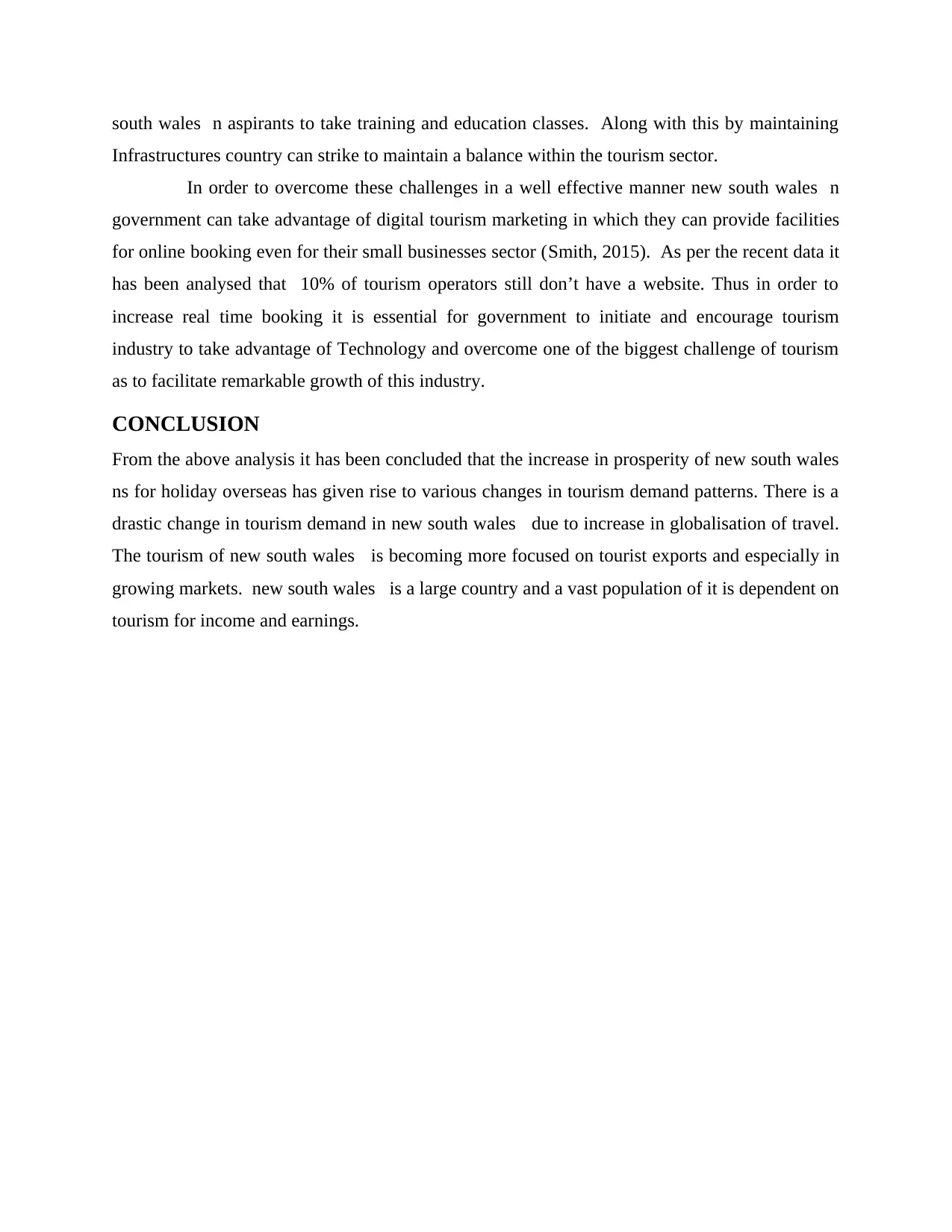
south wales n aspirants to take training and education classes. Along with this by maintaining
Infrastructures country can strike to maintain a balance within the tourism sector.
In order to overcome these challenges in a well effective manner new south wales n
government can take advantage of digital tourism marketing in which they can provide facilities
for online booking even for their small businesses sector (Smith, 2015). As per the recent data it
has been analysed that 10% of tourism operators still don’t have a website. Thus in order to
increase real time booking it is essential for government to initiate and encourage tourism
industry to take advantage of Technology and overcome one of the biggest challenge of tourism
as to facilitate remarkable growth of this industry.
CONCLUSION
From the above analysis it has been concluded that the increase in prosperity of new south wales
ns for holiday overseas has given rise to various changes in tourism demand patterns. There is a
drastic change in tourism demand in new south wales due to increase in globalisation of travel.
The tourism of new south wales is becoming more focused on tourist exports and especially in
growing markets. new south wales is a large country and a vast population of it is dependent on
tourism for income and earnings.
Infrastructures country can strike to maintain a balance within the tourism sector.
In order to overcome these challenges in a well effective manner new south wales n
government can take advantage of digital tourism marketing in which they can provide facilities
for online booking even for their small businesses sector (Smith, 2015). As per the recent data it
has been analysed that 10% of tourism operators still don’t have a website. Thus in order to
increase real time booking it is essential for government to initiate and encourage tourism
industry to take advantage of Technology and overcome one of the biggest challenge of tourism
as to facilitate remarkable growth of this industry.
CONCLUSION
From the above analysis it has been concluded that the increase in prosperity of new south wales
ns for holiday overseas has given rise to various changes in tourism demand patterns. There is a
drastic change in tourism demand in new south wales due to increase in globalisation of travel.
The tourism of new south wales is becoming more focused on tourist exports and especially in
growing markets. new south wales is a large country and a vast population of it is dependent on
tourism for income and earnings.
⊘ This is a preview!⊘
Do you want full access?
Subscribe today to unlock all pages.

Trusted by 1+ million students worldwide
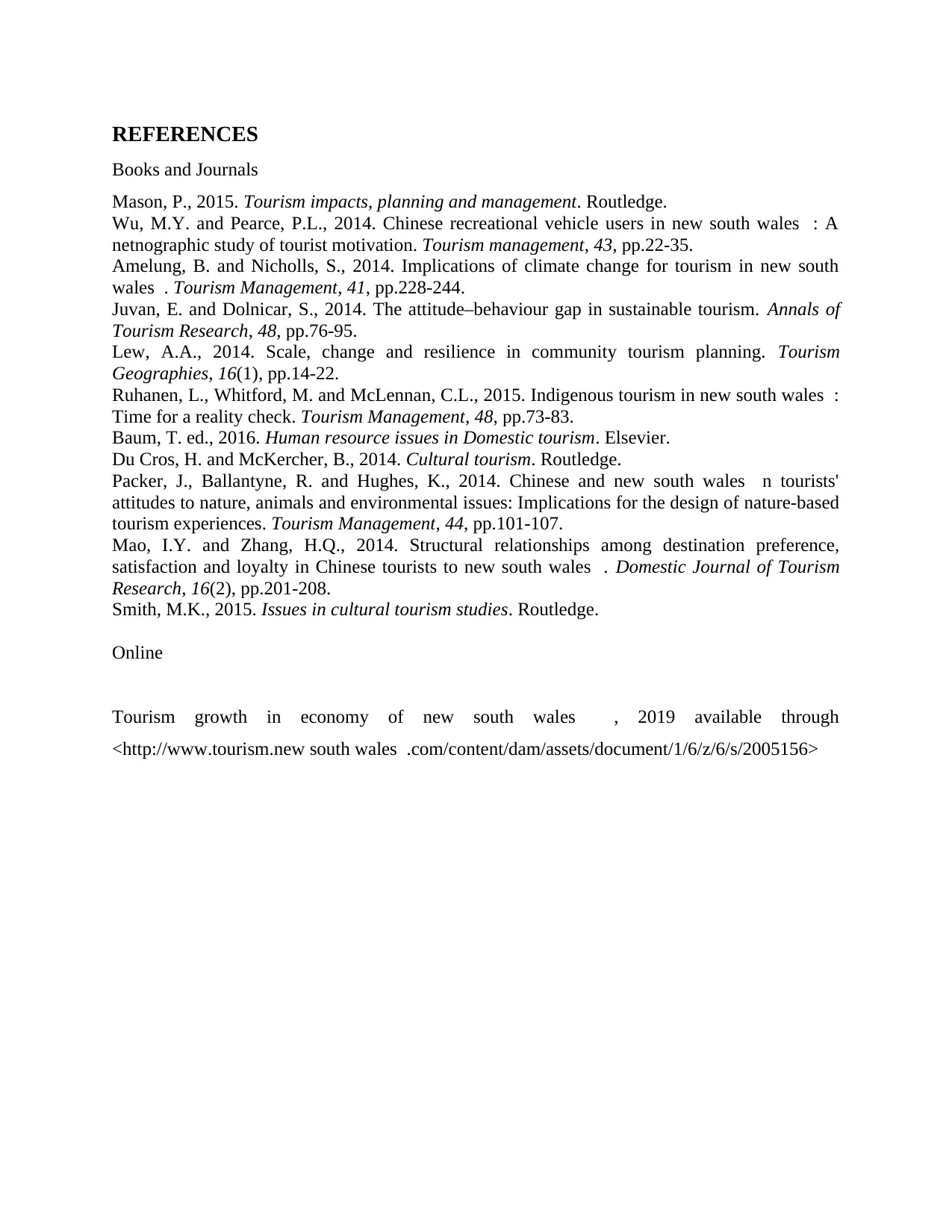
REFERENCES
Books and Journals
Mason, P., 2015. Tourism impacts, planning and management. Routledge.
Wu, M.Y. and Pearce, P.L., 2014. Chinese recreational vehicle users in new south wales : A
netnographic study of tourist motivation. Tourism management, 43, pp.22-35.
Amelung, B. and Nicholls, S., 2014. Implications of climate change for tourism in new south
wales . Tourism Management, 41, pp.228-244.
Juvan, E. and Dolnicar, S., 2014. The attitude–behaviour gap in sustainable tourism. Annals of
Tourism Research, 48, pp.76-95.
Lew, A.A., 2014. Scale, change and resilience in community tourism planning. Tourism
Geographies, 16(1), pp.14-22.
Ruhanen, L., Whitford, M. and McLennan, C.L., 2015. Indigenous tourism in new south wales :
Time for a reality check. Tourism Management, 48, pp.73-83.
Baum, T. ed., 2016. Human resource issues in Domestic tourism. Elsevier.
Du Cros, H. and McKercher, B., 2014. Cultural tourism. Routledge.
Packer, J., Ballantyne, R. and Hughes, K., 2014. Chinese and new south wales n tourists'
attitudes to nature, animals and environmental issues: Implications for the design of nature-based
tourism experiences. Tourism Management, 44, pp.101-107.
Mao, I.Y. and Zhang, H.Q., 2014. Structural relationships among destination preference,
satisfaction and loyalty in Chinese tourists to new south wales . Domestic Journal of Tourism
Research, 16(2), pp.201-208.
Smith, M.K., 2015. Issues in cultural tourism studies. Routledge.
Online
Tourism growth in economy of new south wales , 2019 available through
<http://www.tourism.new south wales .com/content/dam/assets/document/1/6/z/6/s/2005156>
Books and Journals
Mason, P., 2015. Tourism impacts, planning and management. Routledge.
Wu, M.Y. and Pearce, P.L., 2014. Chinese recreational vehicle users in new south wales : A
netnographic study of tourist motivation. Tourism management, 43, pp.22-35.
Amelung, B. and Nicholls, S., 2014. Implications of climate change for tourism in new south
wales . Tourism Management, 41, pp.228-244.
Juvan, E. and Dolnicar, S., 2014. The attitude–behaviour gap in sustainable tourism. Annals of
Tourism Research, 48, pp.76-95.
Lew, A.A., 2014. Scale, change and resilience in community tourism planning. Tourism
Geographies, 16(1), pp.14-22.
Ruhanen, L., Whitford, M. and McLennan, C.L., 2015. Indigenous tourism in new south wales :
Time for a reality check. Tourism Management, 48, pp.73-83.
Baum, T. ed., 2016. Human resource issues in Domestic tourism. Elsevier.
Du Cros, H. and McKercher, B., 2014. Cultural tourism. Routledge.
Packer, J., Ballantyne, R. and Hughes, K., 2014. Chinese and new south wales n tourists'
attitudes to nature, animals and environmental issues: Implications for the design of nature-based
tourism experiences. Tourism Management, 44, pp.101-107.
Mao, I.Y. and Zhang, H.Q., 2014. Structural relationships among destination preference,
satisfaction and loyalty in Chinese tourists to new south wales . Domestic Journal of Tourism
Research, 16(2), pp.201-208.
Smith, M.K., 2015. Issues in cultural tourism studies. Routledge.
Online
Tourism growth in economy of new south wales , 2019 available through
<http://www.tourism.new south wales .com/content/dam/assets/document/1/6/z/6/s/2005156>
1 out of 10
Related Documents
Your All-in-One AI-Powered Toolkit for Academic Success.
+13062052269
info@desklib.com
Available 24*7 on WhatsApp / Email
![[object Object]](/_next/static/media/star-bottom.7253800d.svg)
Unlock your academic potential
Copyright © 2020–2025 A2Z Services. All Rights Reserved. Developed and managed by ZUCOL.





